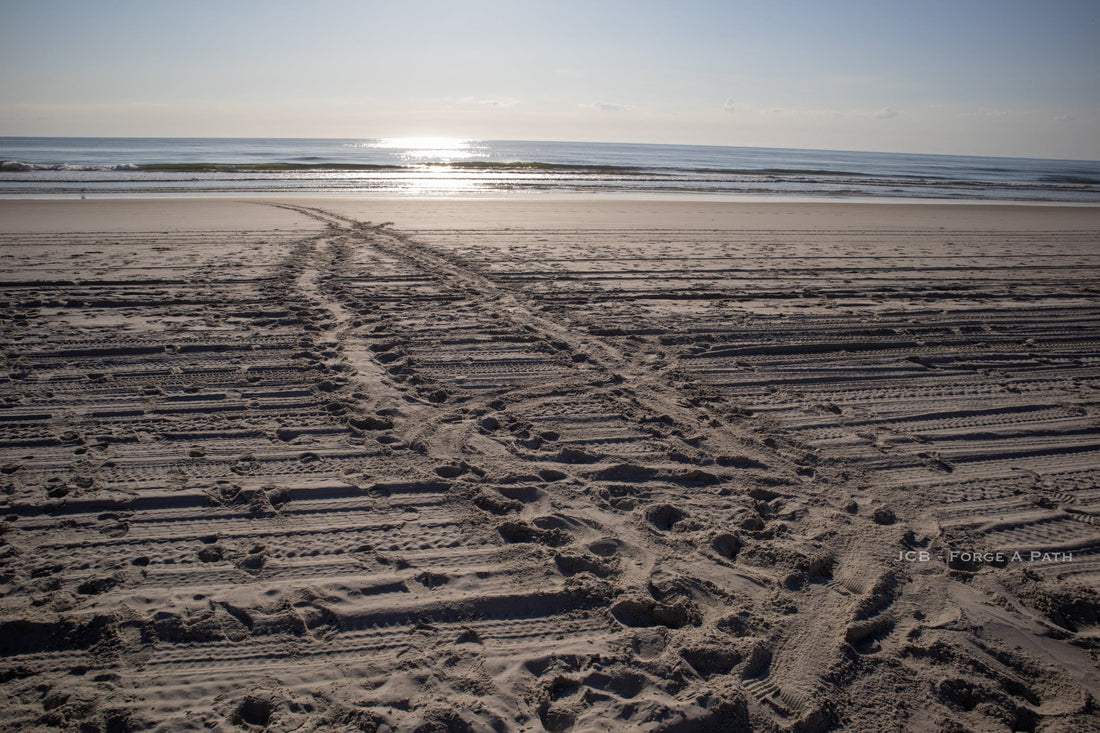
Sea Turtle Nesting Season in Florida: What You Need to Know
Share
The top 3 things I hear from tourists and travelers to Florida: I love sea turtles, where can I see them, and how can you tell what type of sea turtle made this track?
Florida's beaches are home to several species of sea turtles, including the loggerhead, green, and leatherback turtles. These incredible creatures play a vital role in the marine ecosystem, and each year, they return to the same beach they hatched from to lay their own eggs. But what exactly is "sea turtle nesting season", and why is it so important?

Green Sea Turtle near the Matanzas Inlet.
What is Sea Turtle Nesting Season?
Sea turtle nesting season in Florida typically runs from March through October, with peak nesting occurring in June and July. During this time, female sea turtles emerge from the ocean to lay their eggs in the sand. Each nest can contain anywhere from 50 to 200 ping-pong sized eggs, depending on the species. It is also a designated season within each coastal county in Florida that allows for a variety of conservation regulations and groups to perform beneficial acts to help the sea turtles nesting here. That might mean for your next vacation that certain beach rules have changed.
Why is Sea Turtle Nesting Season Important?
Sea turtle nesting season is crucial for the survival of these endangered species. By protecting these beaches where the sea turtles are laying their eggs, the next generation of turtles has a better chance of survival. However, threats to sea turtle nests include habitat destruction, artificial lighting causing disorientation, trash accumulation, and predation by native animals and non-native, like dogs and cats.

How to Identify the Turtle Tracks on the Beach

Have you ever walked along the sandy shores and come across mysterious tracks leading towards the ocean? These tracks are often left behind by sea turtles making their way to or from the water. But how can you identify these tracks and distinguish them from other marks in the sand? Let's dive in and start identifying these sea turtle tracks; helping you to learn how to recognize them with ease.
Distinctive Patterns
Sea turtle tracks are unique and can be identified by their distinct patterns. These tracks typically consist of a series of alternating flipper marks, resembling a set of comma-shaped impressions in the sand, or parallel straight lines with tail drag marks. The spacing between the marks can vary depending on the species of sea turtle and the terrain of the beach.
Size Matters
Another key characteristic of sea turtle tracks is the size of the marks. The flipper imprints left by Leatherback sea turtles are huge, with each mark measuring several feet in width. By comparing the size of the tracks to your hand or foot, you can get a sense of the scale and determine if they belong to a sea turtle.
Track Direction
One of the most telling signs of sea turtle tracks is the direction in which they are headed. Sea turtles typically crawl up the beach in a diagonal or zigzag pattern, leaving a trail that leads from the water's edge to a higher point on the shore where they lay their eggs. Tracks that follow this distinctive path are likely left by a nesting sea turtle.
Additional Clues
In addition to the flipper marks, size, and direction, there are other clues that can help you identify sea turtle tracks. Look for drag marks created by the turtle's body as it moves across the sand. These marks may appear as a continuous line between the flipper imprints, indicating the path taken by the turtle.
By paying attention to these key characteristics, you can become a sea turtle track detective and unravel the mysteries left behind by these ancient mariners. Next time you spot tracks in the sand, take a closer look and see if you can identify the telltale signs of a sea turtle's journey.

Leatherback Sea Turtle: notice the size, the parallel flipper marks, and tail drag in the center.

Loggerhead Sea Turtle: comma-shaped alternating flipper marks

Green Sea Turtle: Parallel flipper tracks with a tail drag; considerably smaller than Leatherback.
How Can You Help Protect Sea Turtles During Nesting Season?
There are several ways you can help protect sea turtles during nesting season in Florida. One important step is to reduce light pollution on the beach, as artificial lighting can disorient hatchlings and prevent them from reaching the ocean. Additionally, be sure to fill in any holes you dig in the sand and remove any beach furniture at night to create a safe environment for nesting turtles.
Remember, sea turtles are a vital part of Florida's marine ecosystem, and it is our responsibility to ensure their survival for generations to come. By following these simple guidelines, you can help protect these incredible creatures during nesting season and beyond.


